Abstract
Guttae phenylephrine 10% produced a significant decrease in intraocular pressure and increase in facility of outflow in eyes with untreated ocular hypertension. If at the same time pigment was released into the aqueous, the pressure and outflow effect was nullified. Guttae pilocarpine 2% also reduced pressure and increased outflow, but if phenylephrine was added to the pilocarpine 2 responses appeared. If no pigment was released, pressure decreased and outflow increased; if pigment was released, there was no significant change in either. An identical response was shown by eyes with treated open-angle glaucoma. In eyes with treated exfoliation glaucoma pilocarpine and phenylephrine combined produced a significant increase in pressure and decrease in outflow because of pigment release. Finally, 18 eyes are described in which pigment release produced a mean increase in intraocular pressure of 14 mmHg. An acute release of pigment has an outflow-blocking effect that can be readily demonstrated. It provides an explanation for some of the paradoxical responses that occur after the instillation of autonomic drugs. It also provides a sufficient explanation for glaucoma associated with pigment dispersion.
Full text
PDF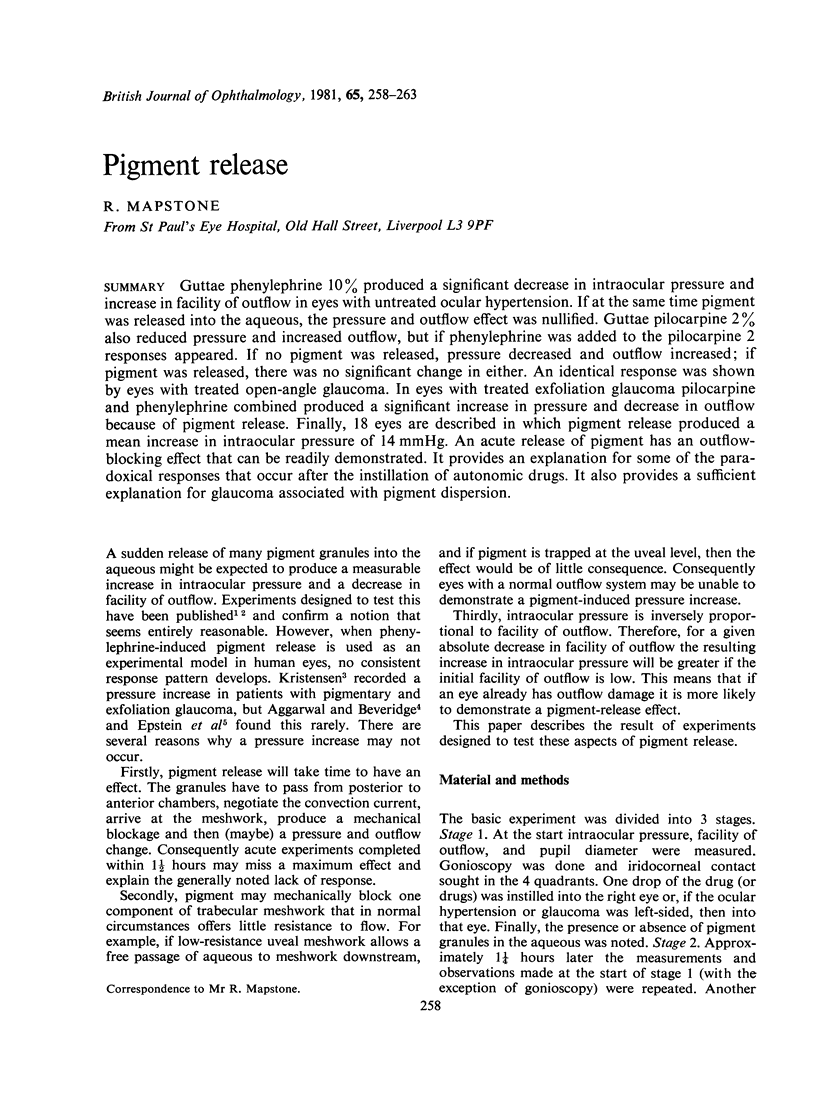
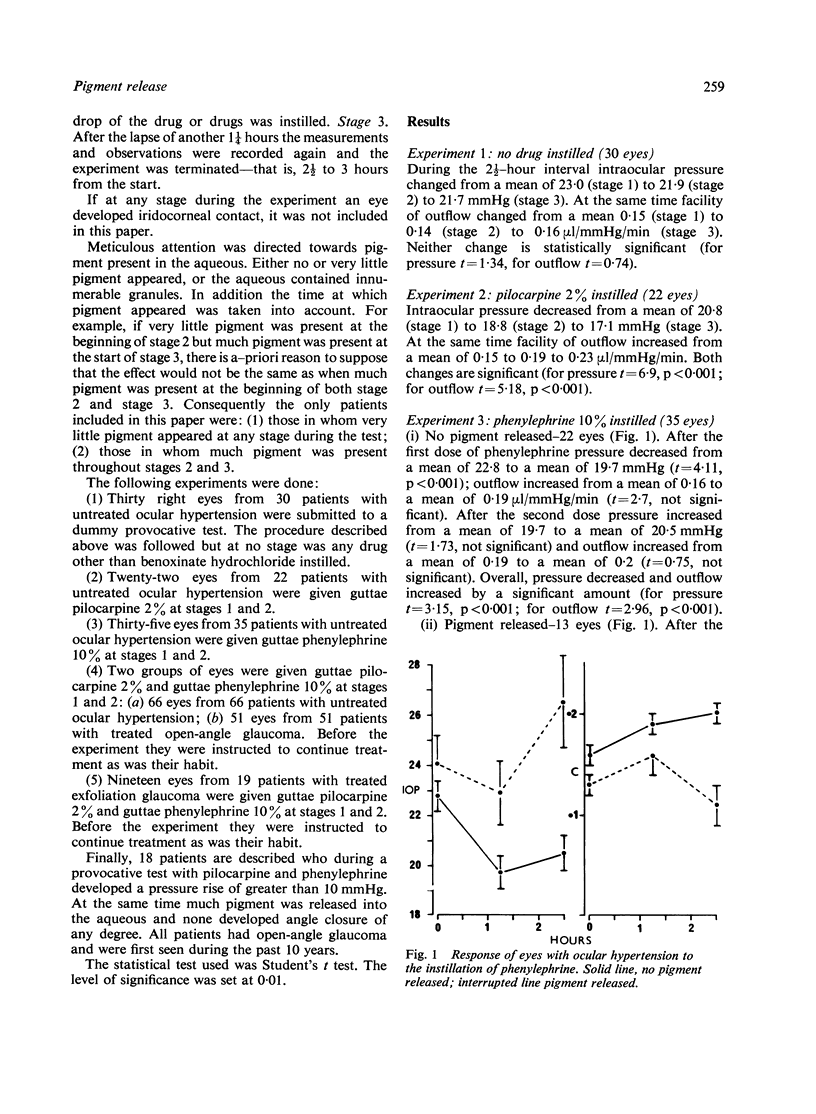

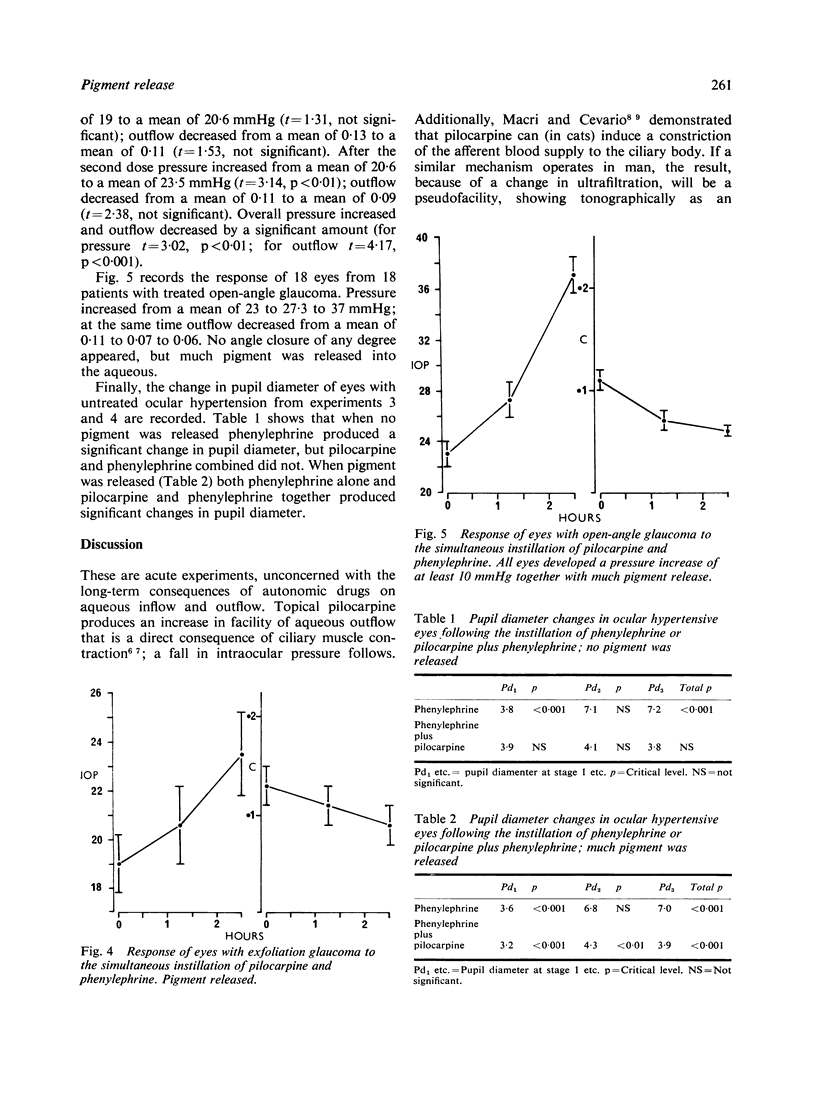
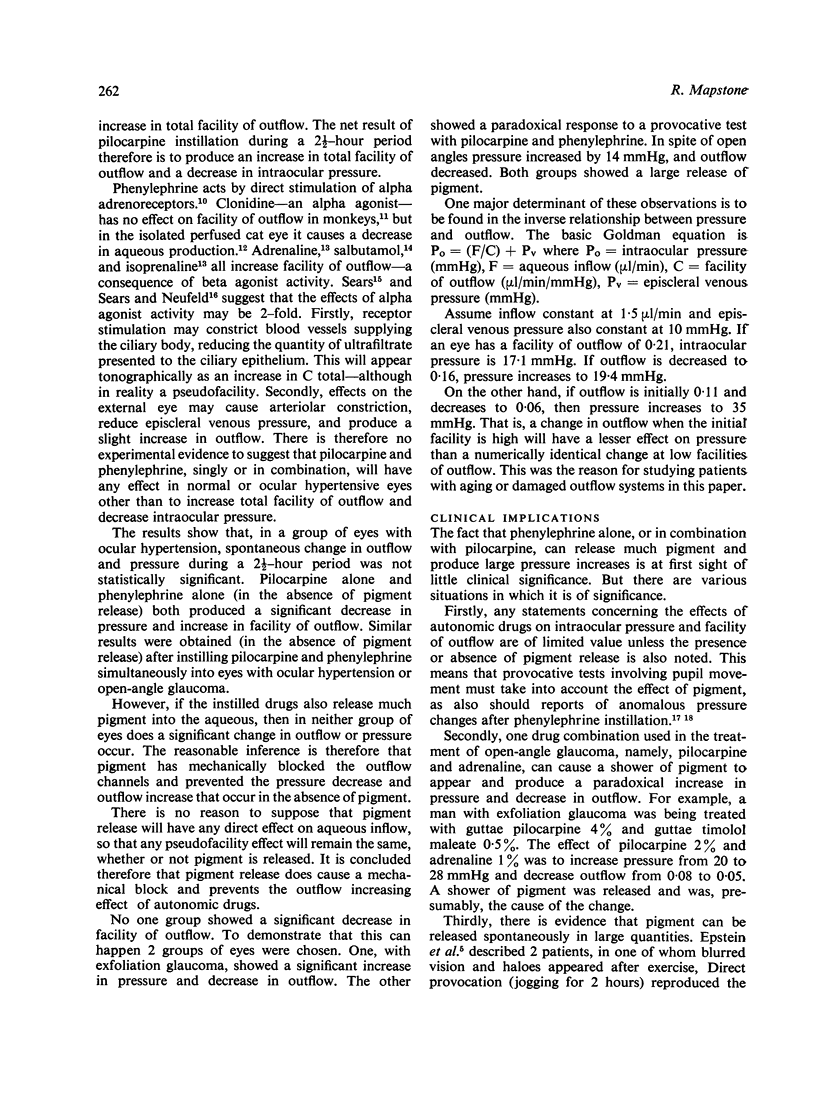
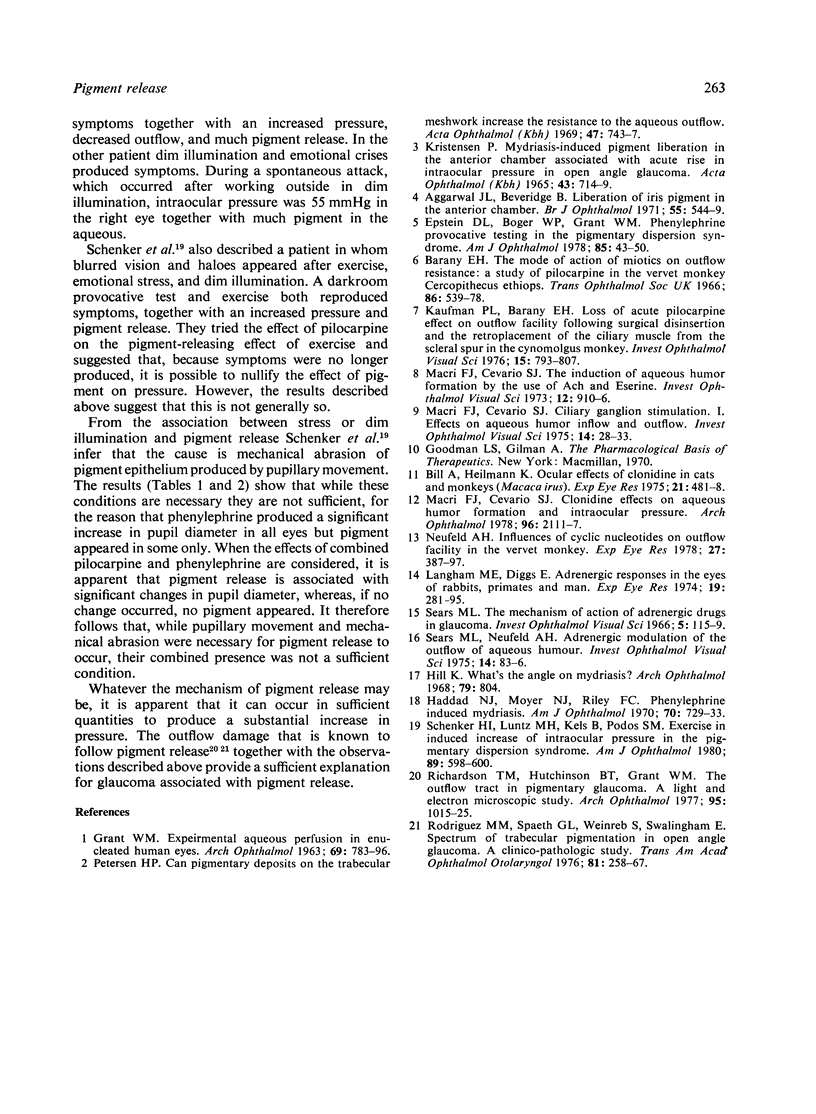
Selected References
These references are in PubMed. This may not be the complete list of references from this article.
- Aggarwal J. L., Beveridge B. Liberation of iris pigment in the anterior chamber. Br J Ophthalmol. 1971 Aug;55(8):544–549. doi: 10.1136/bjo.55.8.544. [DOI] [PMC free article] [PubMed] [Google Scholar]
- Bill A., Heilmann K. Ocular effects of clonidine in cats and monkeys (Macaca irus). Exp Eye Res. 1975 Nov;21(5):481–488. doi: 10.1016/0014-4835(75)90129-3. [DOI] [PubMed] [Google Scholar]
- Bárány E. H. The mode of action of miotics on outflow resistance. A study of pilocarpine in the vervet monkey Cercopithecus ethiops. Trans Ophthalmol Soc U K. 1966;86:539–578. [PubMed] [Google Scholar]
- Epstein D. L., Boger W. P., 3rd, Grant W. M. Phenylephrine provocative testing in the pigmentary dispersion syndrome. Am J Ophthalmol. 1978 Jan;85(1):43–50. doi: 10.1016/s0002-9394(14)76663-2. [DOI] [PubMed] [Google Scholar]
- GRANT W. M. Experimental aqueous perfusion in enucleated human eyes. Arch Ophthalmol. 1963 Jun;69:783–801. doi: 10.1001/archopht.1963.00960040789022. [DOI] [PubMed] [Google Scholar]
- Haddad N. J., Moyer N. J., Riley F. C., Jr Mydriatic effect of phenylephrine hydrochloride. Am J Ophthalmol. 1970 Nov;70(5):729–733. doi: 10.1016/0002-9394(70)90490-3. [DOI] [PubMed] [Google Scholar]
- Kaufman P. L., Bárány E. H. Loss of acute pilocarpine effect on outflow facility following surgical disinsertion and retrodisplacement of the ciliary muscle from the scleral spur in the cynomolgus monkey. Invest Ophthalmol. 1976 Oct;15(10):793–807. [PubMed] [Google Scholar]
- Kristensen P. Mydriasis-induced pigment liberation in the anterior chamber associated with acute rise in intraocular pressure in open-angle glaucoma. Acta Ophthalmol (Copenh) 1965;43(5):714–724. doi: 10.1111/j.1755-3768.1965.tb00343.x. [DOI] [PubMed] [Google Scholar]
- Langham M. E., Diggs E. Beta-adrenergic responses in the eyes of rabbits, primates, and man. Exp Eye Res. 1974 Sep;19(3):281–295. doi: 10.1016/0014-4835(74)90147-x. [DOI] [PubMed] [Google Scholar]
- Macri F. J., Cevario S. J. Ciliary ganglion stimulation. I. Effects on aqueous humor inflow and outflow. Invest Ophthalmol. 1975 Jan;14(1):28–33. [PubMed] [Google Scholar]
- Macri F. J., Cevario S. J. Clonidine. Arch Ophthalmol. 1978 Nov;96(11):2111–2113. doi: 10.1001/archopht.1978.03910060491022. [DOI] [PubMed] [Google Scholar]
- Macri F. J., Cevario S. J. The induction of aqueous humor formation by the use of Ach+eserine. Invest Ophthalmol. 1973 Dec;12(12):910–916. [PubMed] [Google Scholar]
- Neufeld A. H. Influences of cyclic nucleotides on outflow facility in the vervet monkey. Exp Eye Res. 1978 Oct;27(4):387–397. doi: 10.1016/0014-4835(78)90017-9. [DOI] [PubMed] [Google Scholar]
- Petersen H. P. Can pigmentary deposits on the trabecular meshwork increase the resistance of the aqueous outflow? Acta Ophthalmol (Copenh) 1969;47(3):743–749. doi: 10.1111/j.1755-3768.1969.tb08163.x. [DOI] [PubMed] [Google Scholar]
- Richardson T. M., Hutchinson B. T., Grant W. M. The outflow tract in pigmentary glaucoma: a light and electron microscopic study. Arch Ophthalmol. 1977 Jun;95(6):1015–1025. doi: 10.1001/archopht.1977.04450060101010. [DOI] [PubMed] [Google Scholar]
- Rodrigues M. M., Spaeth G. L., Weinreb S., Sivalingam E. Spectrum of trabecular pigmentation in open-angle glaucoma: a clinicopathologic study. Trans Sect Ophthalmol Am Acad Ophthalmol Otolaryngol. 1976 Mar-Apr;81(2):258–276. [PubMed] [Google Scholar]
- Schenker H. I., Luntz M. H., Kels B., Podos S. M. Exercise-induced increase of intraocular pressure in the pigmentary dispersion syndrome. Am J Ophthalmol. 1980 Apr;89(4):598–600. doi: 10.1016/0002-9394(80)90073-2. [DOI] [PubMed] [Google Scholar]
- Sears M. L., Neufeld A. H. Editorial: Adrenergic modulation of the outflow of aqueous humor. Invest Ophthalmol. 1975 Feb;14(2):83–86. [PubMed] [Google Scholar]


